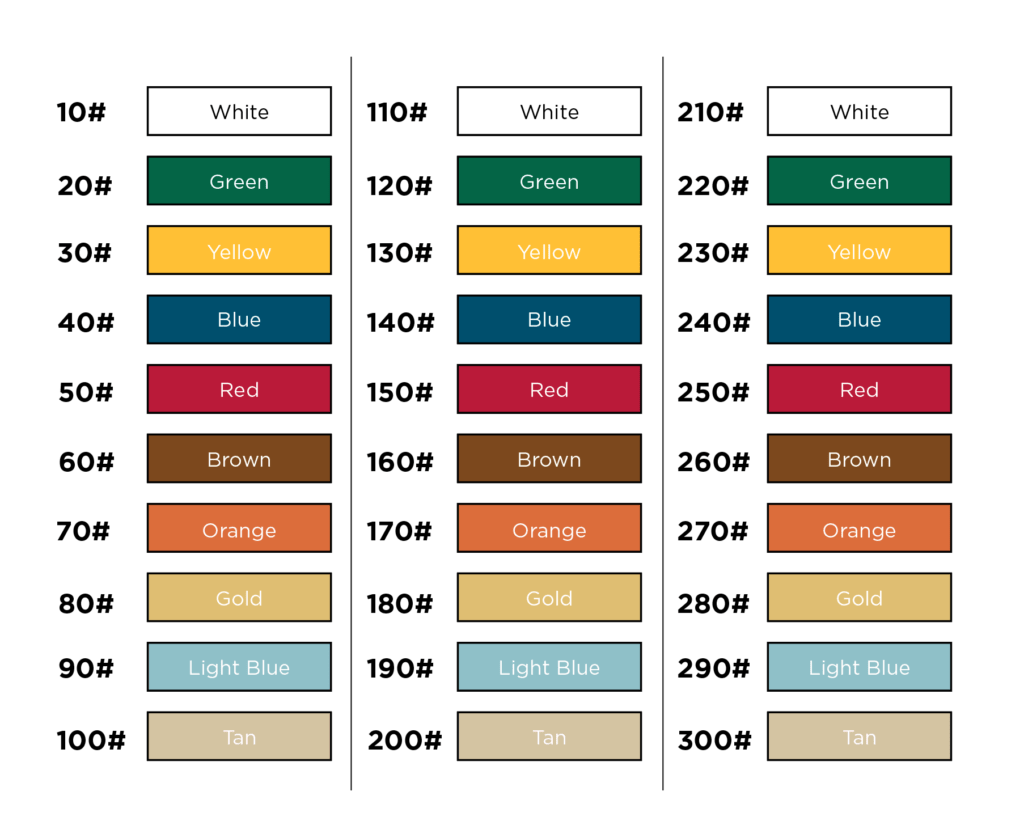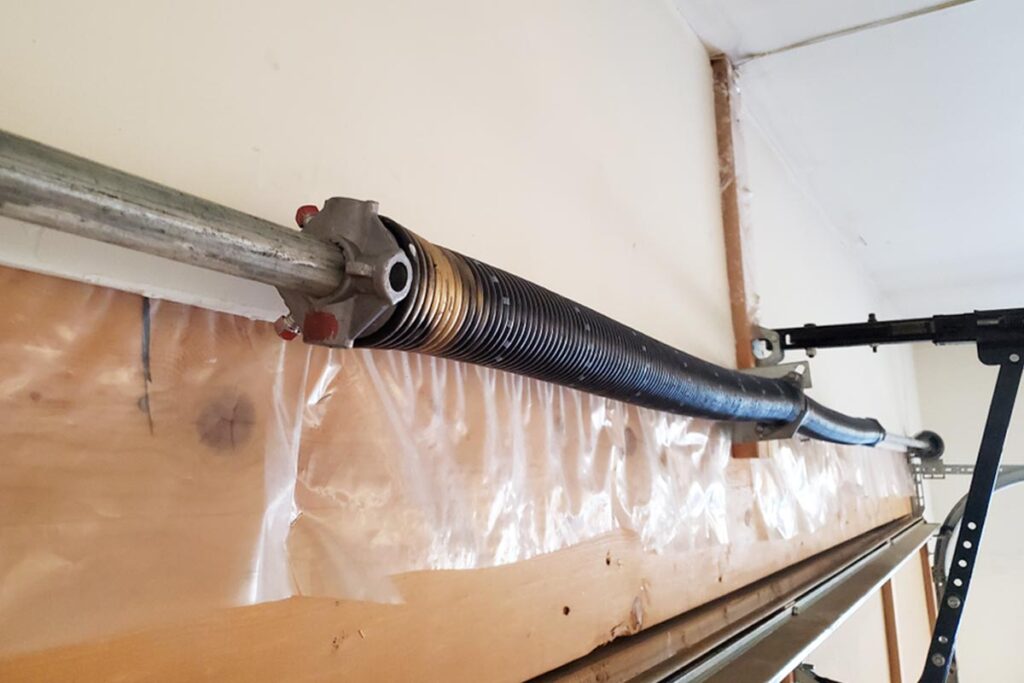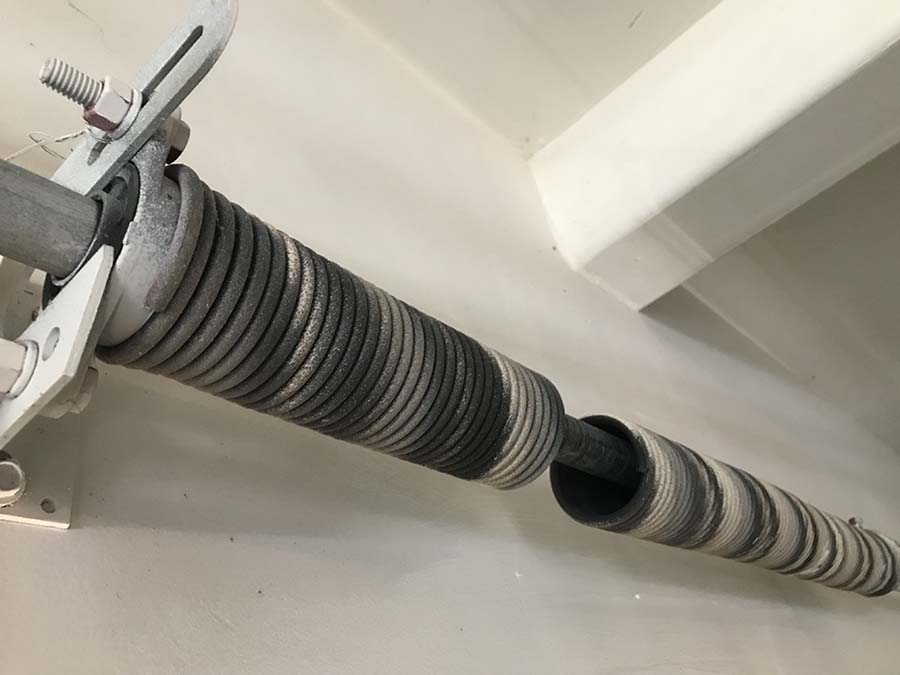Today, I want to talk a little bit about Garage Door Springs, probably one of the most important parts of your garage door. It’s actually what lifts and lowers the door. The spring acts as a counterbalance. And as the door lifts, the spring releases tension until the doors open and the spring is fully relaxed.
Then as you lower the door, the weight of the door puts tension back on the spring. Without the garage door spring, you’re basically going to be deadlifting the entire weight of the door, which is going to be a lot of weight for most people.
Without the garage door spring. Basically, you’re going to have a wall. So the spring is one of the most important parts of the garage door, and it’s probably our most popular or common repair because they are designed to wear out over time with metal fatigue. Your average garage door spring should last about 8 to 12 years based on usage. Normal usage is considered, opening and closing your door in the morning and you go to work coming home, opening and closing it one more time to put your car in.
Some families that use the garage door like their front door, will find that they’ll be replacing springs a little bit sooner. And some families may not use the garage doors often and get a little more life out of them. I always tell people that age and use are really what is involved in how long these springs are going to last.
The two main types of springs, one being the Torsion Spring, which you’ll see on a bar above the front of the garage, or there’s also the extension spring, which will run along the sides of the garage door up above the tracks. So depending on how your garage is set up, will depend on what type of springs you have. Both have their pros and cons. With the smaller doors, you still see the extension springs a lot. Rarely are you going to see these on the bigger doors. Torsion springs you’ll see on just about anything. But let’s dive in a little bit deeper. First with the extension spring.
Garage Door Extension Springs

The extension spring has coil loops on both ends. One ends going to an eye loop near the back of the track on the back hang. The other one’s going to be connected to a yoke and pulley, with a cable that runs to the front and then down to the bottom of the garage door. Closed the springs are fully extended and under full tension. As the door comes up the springs relax and let off tension to assist in lifting the door.
Extension springs are color coded. For example, if it is yellow, that means that this spring is rated for 130 lbs. So based on the color, there’s an industry standard on how much this door should weigh. Some older springs from different companies can have different colors. But for the most part, nowadays, the color codes are going to match up pretty well to know what weight spring is on a door.

When we come in to do a spring repair and are not familiar with the door. We can always look for the color-coded end to make sure to put the right spring on because they do come in different weighted increments for the door. We want almost an exact match to the weight of the door. So it’s properly balanced. A garage door that’s properly balanced will go up by hand nice and easy to come down the same way. You shouldn’t have to be struggling, it shouldn’t feel heavy or want to fly out of your hand. If that’s the case, then you have the wrong springs.
The nice thing about extension springs is they are less expensive to replace compared to a torsion spring. Also, they will allow the door to go un-level just a little bit. So if you have a crooked floor and you’re trying to still get a good seal on it, a lot of times these will allow the door to go a little un-level to kind of make up that gap where a torsion spring door has to stay level to work properly.
One disadvantage is you have to lift the door to spring the extension spring doors without any springs on it. So you basically have to deadlift the door, which can be anywhere from 100 to usually about 150 lbs, over 150lbs you usually don’t see extension springs unless there’s a reason you can’t do torsion, which is the next spring I want to talk about.
Torsion Springs

So this is a similar idea. It’s a coil set. This one’s going to turn rather than pull with tension. So when the door is down, this spring is wound up at full tension, and then as the door lifts, it’s going to release the tension and allow the door to open. When the doors fully open again, like the extension spring is going to be relaxed with no tension on it or very little, just enough to keep the cables on the drums.
They have cones on either side. One is a stationary cone that’s going to bolt to your center mount and the other one is the winding cone with little holes for your winding bars that we use to wind the spring up to the proper tension to lift the door.
They come in left-hand and right-hand wind, which is basically how the spring winds on the torsion tube. You can pair up two or more springs to reach the desired weight and tension for the door they are going to lift. In most cases, if it’s just one spring the wind doesn’t matter unless there’s an obstacle or something and you have to slide it over and just need the room to get the spring on and mounted. Depending on the header and where you’re actually able to mount the springs securely and safely.
They do need to be mounted into something solid above the door just because there is so much tension on it. You don’t want the spring mount to rip out of the wall, which I have seen and can be very dangerous if they’re not properly secured. It’s a big nightmare and we have to come to fix it.
Torsion Springs have three numbers on them. They’re going to have the wire size, the diameter, and the length. The nice thing about the torsion spring too is you can also high cycle it. As I said extension springs should last about 10,000 cycles with the torsion spring a standard one for most residential doors is going to be made to last about the same about 10,000 cycles. But what you can do if you’re one of those families that uses it like your front door and in and out or in commercial applications where the doors opening constantly all day we can get what we call high cycle springs and that will increase the cycles depending on some factors you can change you can go a bigger wire size, you can go for a thicker diameter. There are a couple of different ways you can change these springs out to get you more cycles so the spring will last longer usually a bigger spring with higher cycles ends up being a little bit more money. But if you’re one of those people, again, that knows that you’re going through springs every three to five years because you’re using the door that often, it might be a good idea to look into it and see.
Basically what we do is we calculate the spring as long as the same IPPT, which stands for Inch Pounds Per Turn, and that’s basically how much tension is released off the door as it comes up per turn on the spring. So as long as that’s the same, it means it’s lifting at the same weight at the same rate.
You can change these around, different wire sizes, different lengths. As long as you’re keeping the IPPT the same to get more cycles or maybe you don’t have that much room, and you need to fit it in the tighter space. So you need a shorter spring because as I get shorter, they get stronger, as they lengthen out, they get a little bit weaker. But then usually at that point, then you’re getting a little bit more cycles out of it. There are a lot of different factors with these that you can do to get exactly what you want out of your spring.
Some pros and cons with the torsion spring. It’s a little bit safer than the extension spring because when these springs break, you get a little crack in the middle here when they break, but it’s on a bar above the front of the door so it can’t go anywhere. Where the extension springs can go flying. We do run a safety cable through them, so if they do break, they should stay held up in the air with the safety cable. But when these springs go, it’s a lot of tension and those safety cables can break. It’s not 100%, but when these are on a bar it’s not going anywhere. So these tend to be a little bit safer, and a little bit smoother.

The nicest thing with the torsion spring is you can wind it from the ground with the door closed so that means unlike the extension spring, where the door has to be lifted to be sprung. This you can spring from the ground. So for a heavy door, we always use torsion springs.
The main con is you need a little bit of room above the front of the door. So if you’re in a situation with low head headroom and not a lot of ceiling clearance, these might not fit. There are different ways to do it to try to make them fit. But if you don’t have the room, then sometimes it’s better just to go with extension springs when you’re dealing with a very low headroom situation. For the most part, the torsion spring is a good, solid way to go.
Basically, whether it’s torsion or extension both are common spring systems that we use every day depending on your garage and your setup dictates what springs system we would recommend that you use for your door.
Or if you have a current spring setup that you just need the springs replaced. Now you know a little bit more about what you’re looking for when it comes to getting new or replacement springs for your door, but please leave any comments below with questions about garage door springs.
